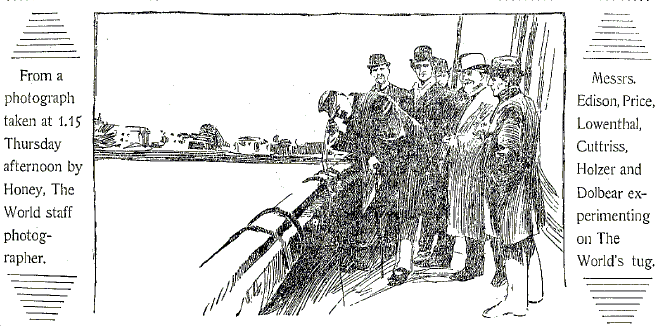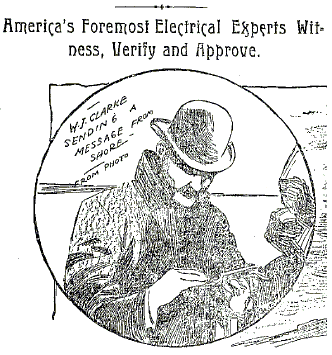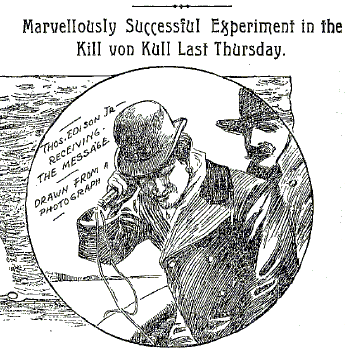BY LIEUT. GEORGE O. SQUIER,
| Depart
| ment Signal Officer in charge of the Submarine Mining of New York Harbor, and Instructor of Electricity at the United States Artillery School, Fort Monroe. |
THIS experiment is most important and timely. Of course, what the Government, and more particularly the Navy Department, wants is such a means of communicating with ships, especially as it will work as well in darkness or fog as at any other time. I certainly hope this matter will be pushed. The authorities at Washington will be apprised of it undoubtedly. Experiments have been conducted under my direction in Fort Monroe.
Tests have also been made in wireless telephony, but not under water. I wish I had been able to witness the experiments conducted by Messrs. Edison, Clarke, Cuttriss and Lowenthal. The enterprise will certainly meet with hearty approbation from those who know what wireless submarine telegraphy will accomplish. Personally I am most eager to see this matter pushed, having been sent abroad to look into it and see what Preece, Marconi and others have done in this direction.
It is doubtful whether telephoning can be done in this way; but if telegraphing can be done from land to ships at sea without wires or visible signals, a wonderful stride forward will have been taken.
|
BY CHARLES W. PRICE,
Editor of the Electrical Review.
THE Sunday World's experiment in submarine telegraphy, which I witnessed off Sailors' Snug Harbor, was a very interesting work and was certainly a laudable enterprise on the part of the paper. It is a great thing for a big newspaper to encourage work in electricity and other scientific fields, especially when there is a chance of the results being of practical value to the Government. The results obtained were most encouraging.
|
BY W. J. CLARKE,
| Invent
| or and Noted Experimenter in Atmospheric Wireless Telegraphy. |
THE Sunday World's demonstration of the working of a system of submarine signalling without the use of direct wire connexion was cleverly conducted by those in charge and seemed to be entirely successful. It is possible that this system may be improved in such a manner as to be of great practical value.
|
|
BY THOMAS A. EDISON, JR.
Inventor and Electrical Expert.
THIS experiment has been an unqualified success. We heard the Morse signals distinctly as long as the boat was within range of the electric waves. Commencing from the Staten Island shore we worked further and further away from the base line--that is, the points on shore where the two copper plates were submerged and connected by a wire running along the shore--almost over to the New Jersey shore.
Of course, if the principle held true to this decree, it is chiefly a matter of strengthening, extending and improving the plant in order to demonstrate its practical value on a large scale.
Marconi and Preece abroad and Mr. Clarke in New York have been working on the idea, and the latter has made some clever instruments. The submarine feature of wireless telegraphy is the new and indefinitely productive feature now made manifest. The next step will be to study out the way to transmit, as well as receive, messages from boat to boat and boat to shore. It is especially important at this time, when the means of communication from the United States to one of its squadrons off shore, say in the neighborhood of Havana, is pre-eminently desirable.
Let the practical, commercial advantages of this means of communication be shown and the value of telegraphy will be enormously increased.
|
BY MAX LOWENTHAL,
| Associ
| ate Editor of the Electrical Engineer. |
THE experiment to-day struck me as particularly valuable in that it showed how the simplest, cheapest kind of a plant will enable those on shore to communicate with those off shore. Delicate and complicated instruments have been made for use in wireless telegraphy, but these are not often obtainable, and the idea that if a ship's captain can be told that if he carries a simple telephone receiver parties on shore having merely a couple of copper plates and a telegraph key can send him information or instruction is most engrossing.
Recently it has been my business to look into this matter and I was greatly gratified to be one of those invited to observe Mr. Dolbear's experiments. The World and Mr. Dolbear have every reason to feel elated over the developments made to-day.
After the "grounding" of the two wires attached to the telephone receiver on board, one by means of the copper plate thrown over the stern and the other by attaching it to the condensing apparatus, the copper intake pipe, which extended through the bottom of the boat, the clicking of the code message became distinct enough for all practical purposes.
The hope of electricians to bring about telegraphic communication between vessels at sea and distant shores seems about to be realized. Soon the "transmitter" and "receiver" will be deemed essential on board every kind of craft sailing the highways of commerce.
The Bureau of Naval Intelligence and the Engineering Department of the army should be told of this and their bright young men set to work to perfect the idea. It is so simple and so easily carried out that valuable ends could be served by thorough experimentation and installing plants before the Hispano-American war is ended.
|
|





